You have most likely seen usnea, also known as Old Man’s Beard, when you are out in the forest. I see it all the time hanging in long strands from conifers when I’m hiking here in the pacific northwest. What you may not have known is that usnea is a super medicinal lichen! I love it when I find out that a plant (or lichen in this case) that I’ve seen for years is beneficial in some way. Foraging for usnea and learning how to identify it isn’t difficult and is the first step to using this powerful natural medicine.
Wildcrafting Weeds
If you want to learn more about the edible and medicinal weeds that surround us and how to use them, check out my eBook: Wildcrafting Weeds: 20 Easy to Forage Edible and Medicinal Plants (that might be growing in your backyard)!
Gather & Root Online Foraging Course
My online foraging course is a great way to learn about wild edible and medicinal plants! Sign up to learn more the gather + root online foraging course here.
Foraging & Identifying Usnea Lichen
Usnea is a lichen that grows worldwide on the bark of trees, usually conifers, but can also be found on oak, hickory, walnut, and apple trees.
It often grows in long beard like strands, which is where it got the nicknames Old Man’s Beard and Beard Lichen.
The best way to positively identify usnea is to gently pull apart the strands and see that it has a stretchy white core in the center. Usnea is the only lichen with a white core.
Usnea is a great plant to forage in the fall and winter time when there isn’t much else available.
Related: What to Forage in Winter: 30+ Edible and Medicinal Plants and Fungi
Harvesting Usnea Lichen Sustainably
When collecting usnea, it is best to only gather what has fallen to the forest floor, rather than taking it straight from the tree itself. This is because lichens grow very slowly which makes them at risk for over-harvesting.
When you are out walking in the woods where usnea grows, keep an eye out for usnea on fallen branches and gather from there. I usually have no trouble finding usnea on the ground in forests where it is growing abundantly.
One interesting thing to note is that lichens like usnea are sometimes used to determine air quality because they won’t survive in polluted air.
So if you are in a forest that is full of usnea, breath deep because the air is pure!
Usnea Medicinal Benefits
While usnea is technically edible, it isn’t particularly tasty and can cause some stomach upset if it isn’t leached properly.
Where usnea really shines is with its amazing medicinal benefits!
First and foremost, usnea is an immune system tonic and has powerful antibiotic and antiviral properties.
It has amazing benefits for the respiratory system and can effectively help to heal bronchitis, pneumonia, sinus infections, strep throat, colds, flus, and other respiratory complaints.
Usnea is also highly beneficial for urinary tract and kidney infections.
The best way to use usnea for health, respiratory, and immune system benefits is to make an usnea tincture.
It can also be made into a tea, but it is very bitter and doesn’t taste very pleasant.
Usnea is also well known as a wound healer and helps to prevent infection. It can be made into a poultice to be applied directly on a wound, which is good to know when you are out hiking in the woods!
If you prefer to buy tinctures rather than make your own, I highly recommend Herb Pharm! They carry Usnea Tincture, as well as different immune boosting blends, alcohol-free glycerites, and products for kids. Use this code for 15% off your order: COLLEEN15
Herb Pharm products can also be found on Amazon here.
Usnea is such a great lichen to know about!
It grows almost everywhere and has some amazing medicinal benefits. It is a very safe herb that can be used by the whole family.
Take some care when collecting it and bring it home to turn it into a tincture to include in your herbal apothecary for optimum wellness!


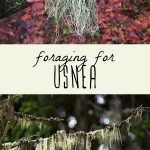
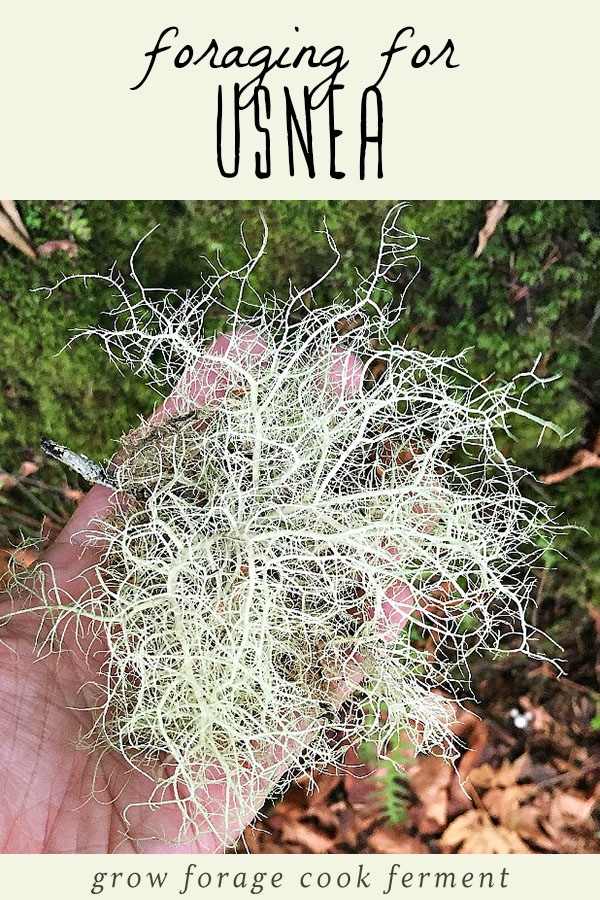
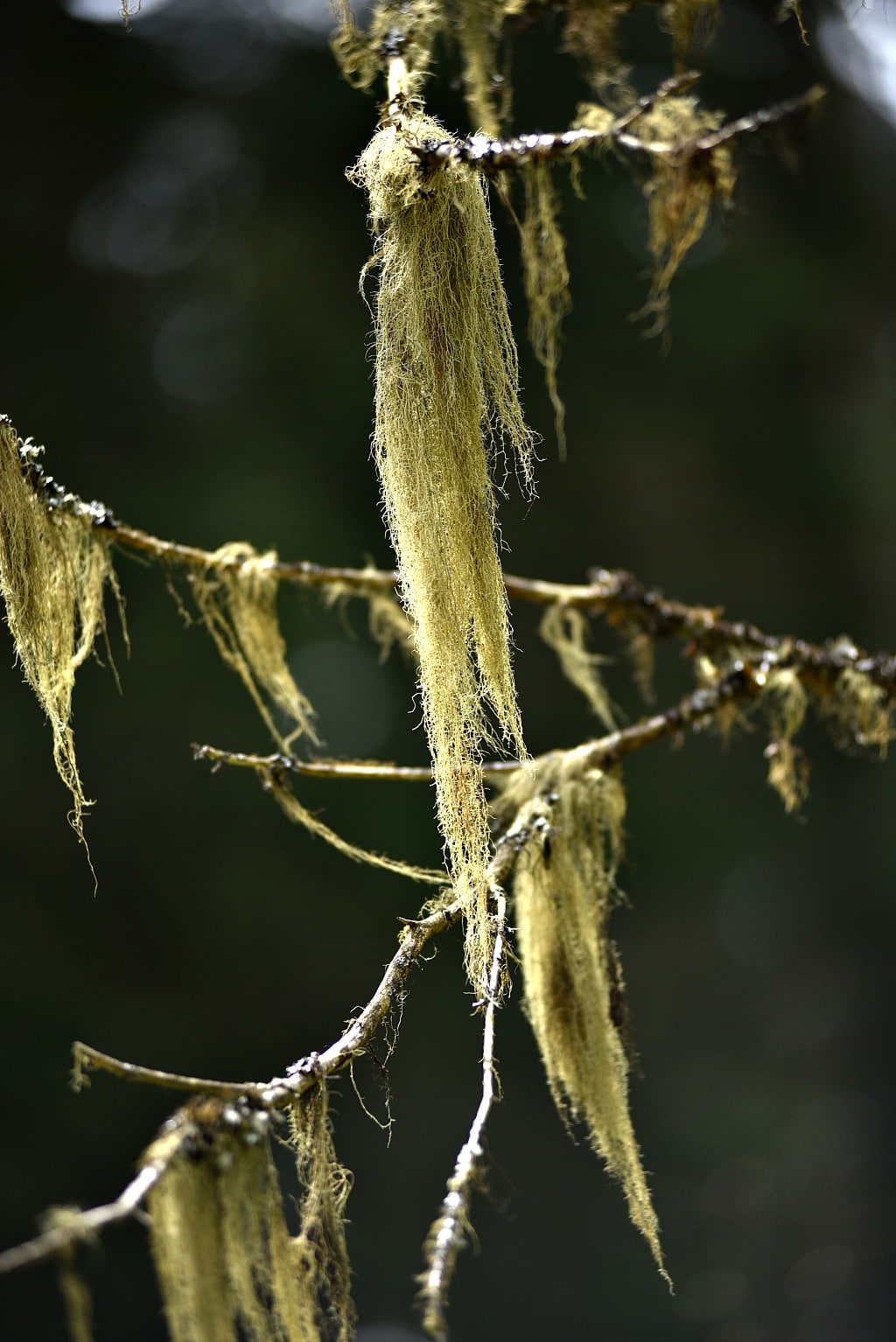
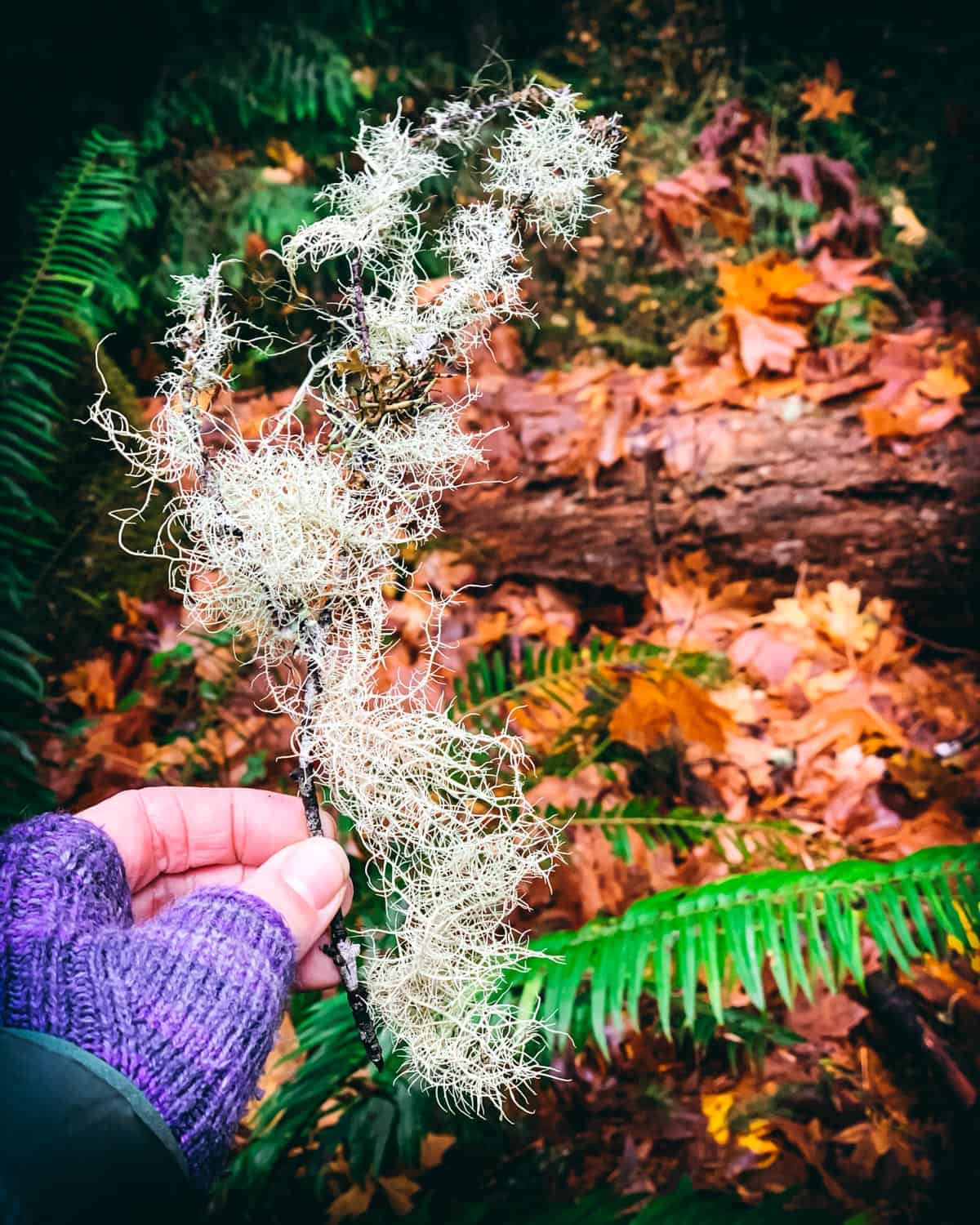
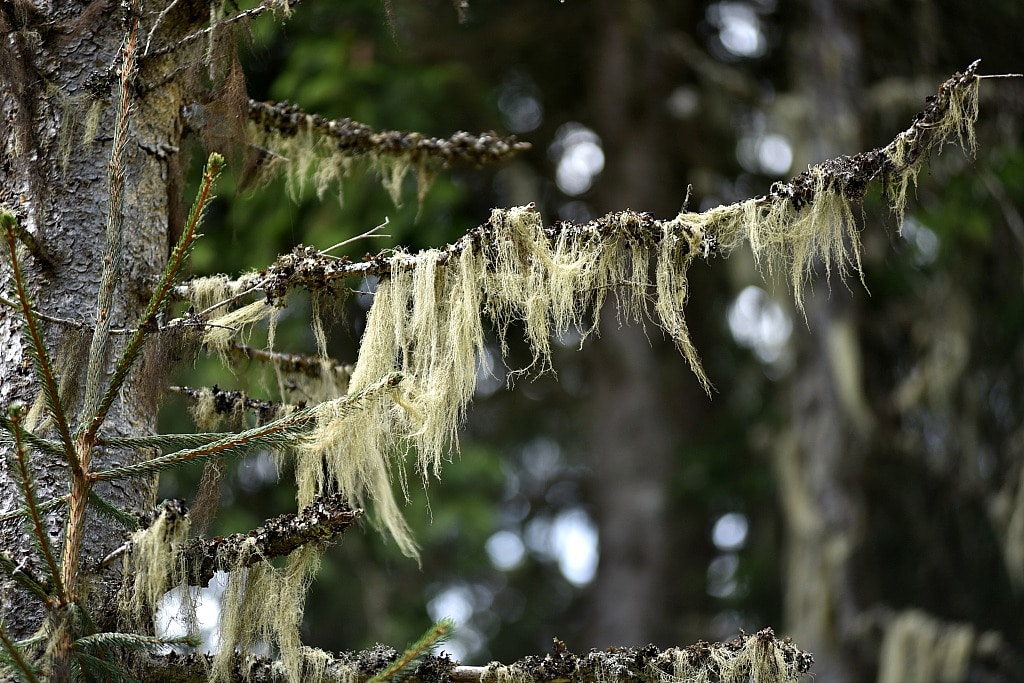
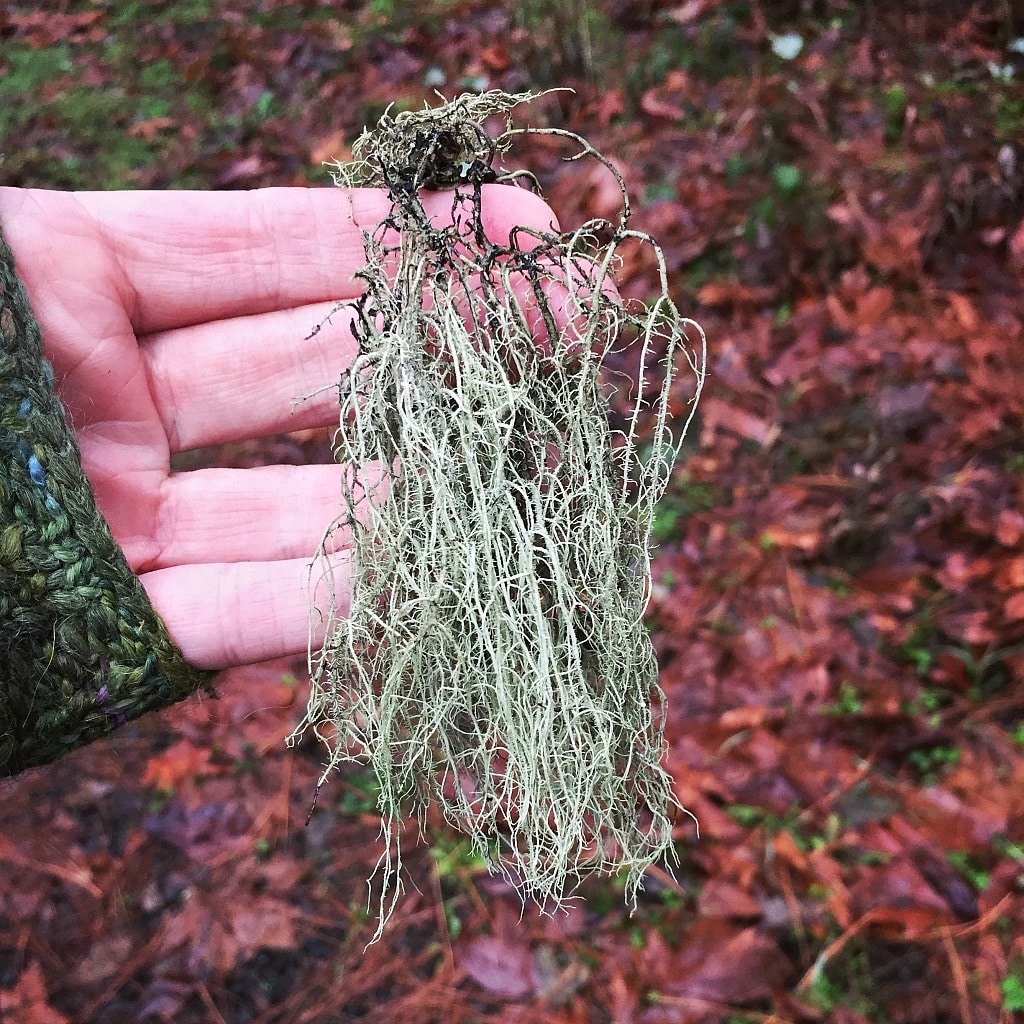

I live in North East Indiana. Usnea does not grow here. Could I pay you to ship me some?
Please and Thank you
Brenda
Hi Brenda. Unfortunately, I cannot do that, however, there are lots of herb shops online that sell it.
I’ve been usnea in a tea form as a water replacement in my soap making. I also add dried ground acorns. The lather in my soap is amazing and it’s incredibly soothing on skin that has a rash or cut. I call it Oak and Lichen
Love this! Do you use the entire amount of water called for in the soap recipe in this tea form? And how much of the usnea do you use to infuse the water? Thank you.
It may grow in a lot of areas, but it doesn’t grow here in Nebraska. Have a friend moving up here from Texas, hoping she remembers to bring me some. Would love to use it for a lot of things.
I made a tea and used it to wash my face. It helped with acne.
I was curious though, it is a good sponge it soaks up the toxins in the air.. how should I go about ensuring that the usnea is detoxified from environs (if taken from fallen branch near a busy street) ?
I don’t think there’s any way for us to know for sure outside of a lab. I prefer to only forage for herbs and plants away from streets and sidewalks.
Thank you for this post! I recently started collecting usnea from the floor but I didn’t know that is best this way.
Do you wash it before using it?
I’m planning on making a tincture with it.
Hi there, check out Michael Moore’s Materia Medica PDF online for dosages of all kinds of herbal medicines. I love usnea, have fun!
I greatly appreciate the medicinal insight being brought to the table. As a mycologists, however, I feel that the information regarding specific foraging habits for Usnea was brief.
It would be great if one took more time to explain WHY people should not collect Usnea from the tree versus the forest floor.
As you mentioned, it takes lichen a great deal of time to grow, these lichen are ancient ancestors that need our protection and discretion. Although I am stoked to share medicinal knowledge, I would appreciate more in depth research on the safest foraging technique for the organism being collected.
For instance, the reproduction method of lichen is mainly fragmentation and therefore the collection of the majority of fallen pieces is detrimental to the next generation. Please use this advice as caution to collect only what you need.
Also, my recommendation would be to acknowledge the indigenous people, where this medicinal tradition came from. Specifically, those whose unceded territory of the Pacific Northwest is where we are currently residing.
Thanks for reading this humble recommendation. Great website! Please reach out if you’d like, peace and love to you!
Thank you for your additional information and appreciaton expressed for the heritage of this information.
A friend gave me some from a tree in her yard. It she cut it from the tree. An I still use it to .and a tincture?
Hi Meghan, a neighbor gave me a bunch of Usnea she gathered from a tree in her yard. Now I am concerned, is it ok to use for a tincture?
If so should I wash & dry it first?
Secondly is there any way I can plant it in another tree. She gave me an abundance of it.
Thank you for your thoughtful suggestions both regarding foraging and honoring indigenous peoples.
You should exercise proper care when using usnea though, look into usnic acid quite a bit more before taking it. Webmd reccomends not exceeding 450mgs of the acid for an average mass adult. It is commonly found in weight loss supplements that have been linked to serious health problems all due to overdosing. So please take care and do your research before enjoying the benefits of all the wonderful plants mother nature has to offer!
A man gave me a tincture of it when I was really ill with pneumonia. IN less than a hour the fever was gone. In two days I was well. This is amazing. Seriously I bought a bottle from him and it helped my husband also. This is GOD sent.
Are you still buying from him and can you post his name?
Hey there I’m curious about if I have the right kind, it doesn’t stretch at all, it’s actually really hard to rip apart. It looks pretty similar in color but the quantity was a lot more on the tree. Wondering if it isn’t the right kind, if it has a use in some way?
I would try to cut it with a knife to see the core to be sure but the treemoss I’ve found have never been very tough it’s pretty fragile actually, especially when it dries it turns to dust almost. Hope this helps! Stay safe!
Great article, thank you. Wondering how you make a poultice with it?
Usnea is a known liver toxin and as such must be used with great care. It isn’t perfectly safe. And for anyone who is going to use it – it may be a very useful medicine – I urge you to do a bit of research first. Start here, maybe…. https://www.ncbi.nlm.nih.gov/pmc/articles/PMC5739313/
That is a very comprehensive resource for Usnea in the scientific literature—thank you!
This is frequently the case when one component of the plant is isolated. Many herbs have components that may be toxic in high doses when isolated from the whole of the plant, which is generally not how herbalism is practiced. This article seems to state just that with the detail of side effects from the isolation of Usnic Acid. Using the whole plant and all its constituents would not give the same effect, but one should always research and use herbs with caution, though they pose a much, much lower threat than isolated chemical pharmaceuticals. The “History of Use of Usena Lichens…” section of this articles shows no such harmful effects.
Haley, whole compound or isolate, the dose is all important. You can as easily overdose on the whole product if you take a same amount of the contained toxin. Granted that it might then seem like a lot of lichen as compared to the toxic isolated component.
It is everywhere. I live in New Mexico. I can walk outside and crab some. I thought it was some kind of perisite that was killing the tree !! thanks for setting that straight!i too could use the info on how much to use.
Does it grow in New York State. My sister makes herbal remedies and lives in central NY State.
It sure does. I live in the Adirondack Mountains and it is everywhere
Usnea is also used as a natural orange dye on wool.
I live in country Victoria, Australia and we have 280 acres of pine forest. Will look for this lichen. We do have plenty of Saffron cap mushrooms and slippery jacks though. Any medicinal uses for these?
I’m in country Victoria too! Would love to correspond with you!
Where can I get info on dosages of the tincture?
Hi there, check out Michael Moore’s Materia Medica online for dosages on herbal medicines of all kinds, including usnea. Have fun!
Hello!
I live in Randolph, Maine and I was wondering if Usnea could be found here?
I live in the next town over from you…Yep, go for a walk in the woods… It’s everywhere! ☺️
i have found it in leeds maine and pemaquid maine
I have found it in Hancock County
Where I live in southern Ohio, I yet have to seen this lichen on any of the trees in my area and mind you I hunt so the woods are common folk and friends to me from the age of 3 until the new to be age of 63…So I am going to search the government lands and talk to the forest rangers to help me find this cool and interesting lichen…Wish me
What part of the country does this grow?
It grows almost everywhere!
I’m not sure where Randolph is in Maine but when I cross into oxford county, I have found it in the woods there. Hope this helps.
Do you know the millimeters pet “dropper” for the tinture dosage? I can’t find it anywhere. :/ Thanks.
Are all the Usnea species medicinal? We have several species here in the South West of England. I use a lot of our native plants both as food and medicine but had not considered using Lichen. Not sure why I have overlooked such a valuable one but aim to now if I have the right species here.
As long as it is Usnea and not another lichen then it is medicinal.
There are many varieties of USNEA! Are they all medicinal. Which variety is the best?
Thanks for the education!! I will be looking for this around my property! :)
Thanks Colleen, Yes, it is a great herb!
Another point to raise is that it is sensitive to toxic environmental chemicals – so it’s prolific growing presence is a sign of good air quality…
Yes! I did mention that in the post :)
I’ve admired this beautiful lichen for a long while and was extremely happy to come across your article and pictures and finally know how truly wonderful and healthful it is. It grows in abundance here in SW Wa. on our Alder and Fir trees, the short kind on the Alder and the long kind on the Fir trees mostly. After yesterdays wind storm left Usnea strewn across our yard I collected some and made a pot of tea with a few Rosehips and Hawthorn berries added, it was delicious. Thank you for the tincture information also.
Thank you for posting this article on the usnea! We have so much of it around on our property and i have always enjoyed picking it up just to look at it. But today i will go and pick it up to make this!